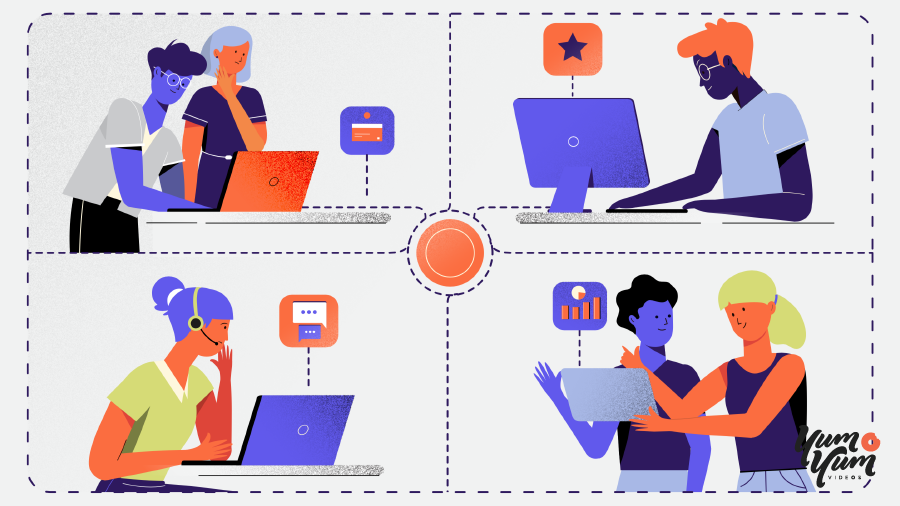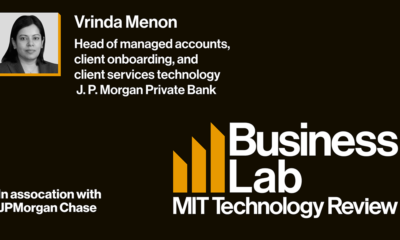Politics
Understanding the Importance of Online Education Platforms After a Pandemic – ReadWrite
Published
3 years agoon
By
Drew Simpson
The pandemic changed the world in many respects, and one of the most affected sectors was – and still is – the educational system. Schools, universities, and other traditional institutions worldwide had to close their doors and send their students home.
While some of them were able to move their classes online thanks to pre-existing remote platforms quickly, most authorities and teachers were caught off guard and unprepared. Struggling to catch up and provide effective solutions.
Importance of Online Education Platforms After a Pandemic
What is the impact of social distancing in education? Can we explore some implementations of educational video platforms that have proved to be successful over the past year?
The New Reality of Remote Learning
We already know that e-learning can be very effective because students can tailor their own experiences to make the process more enjoyable.
– – The Key: Students learning at their own schedule and pace, with the possibility of going back, skipping, or re-reading when they need or want to.
However, for students to be able to learn at their own speed — it’s critical to have access to the right technology, IT structure, and digital knowledge. In this case, when the pandemic hit the world, both educators and students were suddenly forced to relocate the school to their homes — learning on-the-go how to make the new remote learning experience work.
How did the “new reality” of digital and remote learning impact education?
For one thing, the teacher-student interaction is different in a virtual class. In a classroom, instructors are constantly making adjustments to their lessons in response to how students react to them. Something that’s much more difficult to achieve through a camera, especially when it comes to identifying someone that could need extra support.
Another important factor is the attention element, particularly with younger students. It can be pretty easy for teenagers and kids to get distracted, doubly so if you consider that the Internet and social media platforms are only a click away. That alone may result in low or more limited interaction levels during the socially distanced class.
To be effective, online classes need to be presented and structured differently.
It’s important to remember that learning works because (and when) it’s a social and engaging activity. Therefore, teachers need to adapt their lessons to enhance the virtual experience and make it more interactive, for example, using compelling educational videos or interactive slide presentations.
Ultimately, the goal is to motivate students and encourage them to get involved online or not. So, integrating fun games and activities to apply what they’ve learned, or assigning hands-on projects that they can do at home, has become more important than ever.
Also, good and constant communication is vital. Educators should take advantage of the many collaboration tools available and create a more class-like social-learning environment. For example, using chat groups, video meetings, and document sharing to regularly reach out to students and be present.

UNESCO’s vision of online education and flexible learning pathways
Higher education – universities and other tertiary institutions – has never been more diverse. In addition to “traditional” students, there are part-time learners, older people going back to school, and international students — all with different objectives, challenges, and needs.
As a response, UNESCO’s International Institute for Educational Planning presented a project – which includes eight in-depth country case studies – to guide institutions to identify tools that can support flexible learning pathways. That is, an educational system that allows entry and re-entry points at all ages and educational levels, links between formal and non-formal structures, and validation of knowledge or skills obtained from informal education.
Within the new post-social distancing context, there are many examples of flexible learning and online education that can be taken from the project and applied to the new normal.
For example, in India, there’s a platform – SWAYAM – with access to multiple online courses that are recognized by several higher education institutions. A student entering a university can transfer credits from those online courses and complete an academic program.
On a similar note, the Open University Malaysia offers super flexible education programs so that students can tailor their studies at their own convenience. Basically, it provides online learning programs, digital tutoring, forums to communicate with teachers and peers, and credit transfer from previous education.
Now, implementing online education (while ensuring quality) is not an easy task. Besides all the important issues related to technology and connectivity, not all classes can be successfully supported by digital technology, for example, practical science or lab-based programs.
However, making e-learning part of the present – and future – of higher education seems to be the way to go — Especially when it comes to creating new, more effective methods that can allow more flexible education in terms of delivery and access.

Distance learning solution’s spotlight: Online education at its best
Online education can “take” many forms – eBooks, real-time classes, video courses, online interactive activities, and so on. Now, given that the format is super versatile, engaging, and helps you convey a lot of information in a short amount of time, we’ve chosen examples of online education done with video. Some of them are more simple and were self-produced, while others were developed by talented educational video creators.
What do they all have in common? First, they showcase the amazing power and versatility of these tools when implemented correctly.
Animation
Few things are more compelling, creative, and memorable than animation, especially when combined with solid storytelling. It doesn’t matter how abstract, flat, or hard-to-grasp a concept can be; using animation, you can make the message more approachable, engaging, and understandable. Like this educational video that thoroughly covers the topic of inbound marketing in less than three minutes!
Live lectures recording
Recording a lecture and then uploading it to a YouTube tutorial, Instagram how-to video, or a remote platform is another great and simple way to make online education happen. Here’s an example of how the Department of Political Science at Duke University does it.
They film each class and then upload the material on both YouTube and their website, — making it accessible not only for students that missed the class but also to anyone interested in the subject!
Lightboard
These videos almost look like a traditional class – where a teacher does the boardwork while “talking” to an audience – but they’re pre-recorded. They can be beneficial for technical subjects that include graphics, sketches, symbols, etc.
Here’s a short piece developed by Northwestern University explaining why they use it for their online lectures.
Lecture slides
Marrying slides with a lecture to explain a subject or topic is one of the most common online learning methods. Lecture slides resemble a PowerPoint presentation, but it’s narrated, making the content much more dynamic and easier to follow.
Take this example produced by the School of Public Health from the University of Michigan to explain the US healthcare delivery system – It’s simple yet very clear.
Screencast demonstration
Screencast technology is perfect for demonstrating how to use complex software or explaining highly technical topics, such as math problems or equations. For example, the following video was developed to apply matrix operations in Mathematica, a technical computing system.
Closing Thoughts
Offering a more flexible education – especially in terms of delivery – was unavoidable, especially after Covid-19.
However, only a small percentage of institutions were able to quickly adapt to this sudden change and provide proper online education — revealing that the educational system in most countries of the world is falling behind, at least in terms of IT structure and connectivity.
There’s no doubt that implementing online education is not something that can be done overnight. There are many challenges, not only technologically but also socially.
Hopefully, this pandemic will result in a broader change in education and how it’s approached — transitioning from traditional learning methods to new, more flexible, and inclusive alternatives.
Victor Blasco
Victor Blasco is an audiovisual designer, video marketing expert, and founder/CEO of the explainer video company Yum Yum Videos. Besides running the business, he’s a lifelong student of Chinese philosophy and a passionate geek for all things sci-fi.
You may like
-


How open-source drug discovery could help us in the next pandemic
-


Child online safety laws will actually hurt kids, critics say
-


The Download: child online safety laws, and ClimateTech is coming
-


The Importance of Diversity and Inclusion in Building a Strong Tech Team
-


Optimizing platforms offers customers and stakeholders a better way to bank
-


Digital PR: Building an Online Reputation and Boosting Visibility
Politics
Fintech Kennek raises $12.5M seed round to digitize lending
Published
6 months agoon
10/11/2023By
Drew Simpson
London-based fintech startup Kennek has raised $12.5 million in seed funding to expand its lending operating system.
According to an Oct. 10 tech.eu report, the round was led by HV Capital and included participation from Dutch Founders Fund, AlbionVC, FFVC, Plug & Play Ventures, and Syndicate One. Kennek offers software-as-a-service tools to help non-bank lenders streamline their operations using open banking, open finance, and payments.
The platform aims to automate time-consuming manual tasks and consolidate fragmented data to simplify lending. Xavier De Pauw, founder of Kennek said:
“Until kennek, lenders had to devote countless hours to menial operational tasks and deal with jumbled and hard-coded data – which makes every other part of lending a headache. As former lenders ourselves, we lived and breathed these frustrations, and built kennek to make them a thing of the past.”
The company said the latest funding round was oversubscribed and closed quickly despite the challenging fundraising environment. The new capital will be used to expand Kennek’s engineering team and strengthen its market position in the UK while exploring expansion into other European markets. Barbod Namini, Partner at lead investor HV Capital, commented on the investment:
“Kennek has developed an ambitious and genuinely unique proposition which we think can be the foundation of the entire alternative lending space. […] It is a complicated market and a solution that brings together all information and stakeholders onto a single platform is highly compelling for both lenders & the ecosystem as a whole.”
The fintech lending space has grown rapidly in recent years, but many lenders still rely on legacy systems and manual processes that limit efficiency and scalability. Kennek aims to leverage open banking and data integration to provide lenders with a more streamlined, automated lending experience.
The seed funding will allow the London-based startup to continue developing its platform and expanding its team to meet demand from non-bank lenders looking to digitize operations. Kennek’s focus on the UK and Europe also comes amid rising adoption of open banking and open finance in the regions.
Featured Image Credit: Photo from Kennek.io; Thank you!
Radek Zielinski
Radek Zielinski is an experienced technology and financial journalist with a passion for cybersecurity and futurology.
Politics
Fortune 500’s race for generative AI breakthroughs
Published
6 months agoon
10/11/2023By
Drew Simpson
As excitement around generative AI grows, Fortune 500 companies, including Goldman Sachs, are carefully examining the possible applications of this technology. A recent survey of U.S. executives indicated that 60% believe generative AI will substantially impact their businesses in the long term. However, they anticipate a one to two-year timeframe before implementing their initial solutions. This optimism stems from the potential of generative AI to revolutionize various aspects of businesses, from enhancing customer experiences to optimizing internal processes. In the short term, companies will likely focus on pilot projects and experimentation, gradually integrating generative AI into their operations as they witness its positive influence on efficiency and profitability.
Goldman Sachs’ Cautious Approach to Implementing Generative AI
In a recent interview, Goldman Sachs CIO Marco Argenti revealed that the firm has not yet implemented any generative AI use cases. Instead, the company focuses on experimentation and setting high standards before adopting the technology. Argenti recognized the desire for outcomes in areas like developer and operational efficiency but emphasized ensuring precision before putting experimental AI use cases into production.
According to Argenti, striking the right balance between driving innovation and maintaining accuracy is crucial for successfully integrating generative AI within the firm. Goldman Sachs intends to continue exploring this emerging technology’s potential benefits and applications while diligently assessing risks to ensure it meets the company’s stringent quality standards.
One possible application for Goldman Sachs is in software development, where the company has observed a 20-40% productivity increase during its trials. The goal is for 1,000 developers to utilize generative AI tools by year’s end. However, Argenti emphasized that a well-defined expectation of return on investment is necessary before fully integrating generative AI into production.
To achieve this, the company plans to implement a systematic and strategic approach to adopting generative AI, ensuring that it complements and enhances the skills of its developers. Additionally, Goldman Sachs intends to evaluate the long-term impact of generative AI on their software development processes and the overall quality of the applications being developed.
Goldman Sachs’ approach to AI implementation goes beyond merely executing models. The firm has created a platform encompassing technical, legal, and compliance assessments to filter out improper content and keep track of all interactions. This comprehensive system ensures seamless integration of artificial intelligence in operations while adhering to regulatory standards and maintaining client confidentiality. Moreover, the platform continuously improves and adapts its algorithms, allowing Goldman Sachs to stay at the forefront of technology and offer its clients the most efficient and secure services.
Featured Image Credit: Photo by Google DeepMind; Pexels; Thank you!
Deanna Ritchie
Managing Editor at ReadWrite
Deanna is the Managing Editor at ReadWrite. Previously she worked as the Editor in Chief for Startup Grind and has over 20+ years of experience in content management and content development.
Politics
UK seizes web3 opportunity simplifying crypto regulations
Published
6 months agoon
10/10/2023By
Drew Simpson
As Web3 companies increasingly consider leaving the United States due to regulatory ambiguity, the United Kingdom must simplify its cryptocurrency regulations to attract these businesses. The conservative think tank Policy Exchange recently released a report detailing ten suggestions for improving Web3 regulation in the country. Among the recommendations are reducing liability for token holders in decentralized autonomous organizations (DAOs) and encouraging the Financial Conduct Authority (FCA) to adopt alternative Know Your Customer (KYC) methodologies, such as digital identities and blockchain analytics tools. These suggestions aim to position the UK as a hub for Web3 innovation and attract blockchain-based businesses looking for a more conducive regulatory environment.
Streamlining Cryptocurrency Regulations for Innovation
To make it easier for emerging Web3 companies to navigate existing legal frameworks and contribute to the UK’s digital economy growth, the government must streamline cryptocurrency regulations and adopt forward-looking approaches. By making the regulatory landscape clear and straightforward, the UK can create an environment that fosters innovation, growth, and competitiveness in the global fintech industry.
The Policy Exchange report also recommends not weakening self-hosted wallets or treating proof-of-stake (PoS) services as financial services. This approach aims to protect the fundamental principles of decentralization and user autonomy while strongly emphasizing security and regulatory compliance. By doing so, the UK can nurture an environment that encourages innovation and the continued growth of blockchain technology.
Despite recent strict measures by UK authorities, such as His Majesty’s Treasury and the FCA, toward the digital assets sector, the proposed changes in the Policy Exchange report strive to make the UK a more attractive location for Web3 enterprises. By adopting these suggestions, the UK can demonstrate its commitment to fostering innovation in the rapidly evolving blockchain and cryptocurrency industries while ensuring a robust and transparent regulatory environment.
The ongoing uncertainty surrounding cryptocurrency regulations in various countries has prompted Web3 companies to explore alternative jurisdictions with more precise legal frameworks. As the United States grapples with regulatory ambiguity, the United Kingdom can position itself as a hub for Web3 innovation by simplifying and streamlining its cryptocurrency regulations.
Featured Image Credit: Photo by Jonathan Borba; Pexels; Thank you!
Deanna Ritchie
Managing Editor at ReadWrite
Deanna is the Managing Editor at ReadWrite. Previously she worked as the Editor in Chief for Startup Grind and has over 20+ years of experience in content management and content development.
